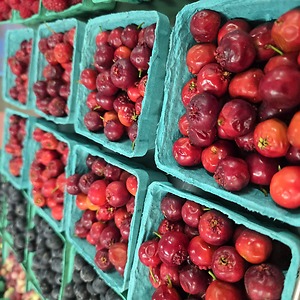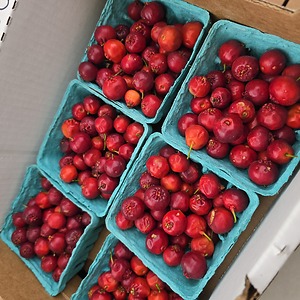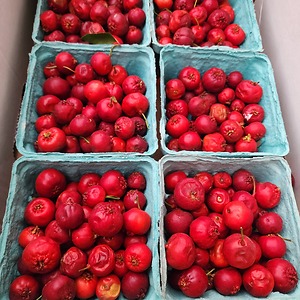


Mayhaw
Estimated Inventory, bskt : 0
This item was last sold on : 06/06/24
Description/Taste
Mayhaw berries are small in size, averaging 1 to 2.5 centimeters in diameter, and have a round to oblate shape with curved, even edges. Each variety will vary in appearance and flavor, but most types have thin, semi-glossy, smooth, and taut skin. Mayhaw berries are found in shades of red, red-pink, purple-red, orange, and yellow, and as they ripen, their exterior may become indented when pressed. Some Mayhaw varieties can become delicate and easily damaged once ripe, while others will remain firmer. Underneath the surface, the fruit’s flesh can be red, pink, or white and is creamy, soft, and tender when ripe. The flesh also encases a few tiny seeds. Mayhaw is edible raw once ripe, and has a tart, acidic, sour, bitter, bland, and astringent taste, depending on the variety. Most berries are cooked with a sweetener before consumption to create a more palatable flavor, balancing the zingy nuances with sweet notes.
Seasons/Availability
Mayhaw berries are available in the late spring in North America, typically ripening between mid-April and May.
Current Facts
Mayhaw berries, botanically a part of the Crataegus genus, are a category of fruits found in North America belonging to the Rosaceae family. Three main species are found under the general Mayhaw name, including Crataegus aestivalis, Crataegus opaca, and Crataegus rufula, and the fruits are sometimes collectively known as Riverflat Hawthorn, Thorny Hawthorn, and May Hawthorn. Within each species, there are individual varieties that vary slightly in flavor and appearance. Mayhaw trees generally reach 7 to 9 meters in height, and the fruits ripen in clusters on the tree. Historically, Mayhaw fruits were only available for a few weeks each year and were labor-intensive to harvest as the fruits must be collected once they have ripened and fallen off the trees. In the wild, Mayhaw trees typically grow along bodies of water, resulting in foragers collecting fruits by skimming the water’s surface with buckets. Nets would also be laid at the foot of trees, and the branches gently shaken to loosen ripe berries. Despite these challenges, Mayhaw berries are an anticipated seasonal delicacy, and southern residents fondly recall harvesting the fruits as a family outing. In the present day, Mayhaw berries are commercially cultivated, allowing the trees to be planted in home gardens and orchards for easier harvests. Popular cultivars include T.O. Superberry, Superspur, Saline, Big Red, Crimson, Royal Star, Big V, Texas Star, and Turnage 57. Mayhaws acquired their name from their ripening period in May, combined with “haw,” the beginning of hawthorn, referencing another name for the fruit. The seasonal berries are a treasured seasonal delicacy used by chefs and home cooks in cooked sweet and savory culinary dishes.
Nutritional Value
Mayhaw berries are a source of potassium to balance fluid levels within the body, calcium to support bones and teeth, and magnesium to help the body with daily nerve functions. Mayhaw fruits also provide iron to develop the protein hemoglobin for oxygen transport through the bloodstream and copper to aid in producing red blood cells. Vitamins within the berries include vitamin C to strengthen the immune system and beta-carotene, which is converted into vitamin A in the body to maintain healthy organs.
Applications
Mayhaw berries have an acidic, sometimes sour, astringent, or bitter taste, depending on the variety. They are popularly cooked with sweeteners to create a balanced flavor. In the Southern United States, Mayhaw berries are famous for their use in jellies and jams. There are many recipes for making Mayhaw preserves, and each family will have their own variation, based on flavor and color. During the 1800s, Mayhaw jelly was served with savory dishes using meats like turkey, duck, and venison. Uses for the jelly later evolved for spreading over baked goods and as a pie filling. Try adding Mayhaw jelly to pancakes, muffins, biscuits, tarts, or pound cake. Mayhaw berries are also juiced for fruit punches, wine, and other beverages or simmered into syrup for cakes, ice cream, or puddings. Other preparations include sauces like a variation of honey mustard or folding the berry’s flavoring into butter. Mayhaw berries pair well with pineapple juice, strawberries, grapes, ginger, vanilla, and pecans. Ripe fruits should be immediately used for the best quality and flavor, and will keep for one week when stored in a sealed container in the refrigerator.
Ethnic/Cultural Info
Mayhaws were officially decreed as the state fruit tree of Louisiana in 2014. Earlier in 2003, Mayhaw jelly was selected as one of the two official state jellies, along with Louisiana sugarcane jelly, in honor of the fruit’s rich cultural history within the state. The tree was chosen as the state fruit tree through the efforts of the Louisiana Mayhaw Association. The association suggested that the official title would help increase public awareness and recognition of the trees and strengthen the commercial cultivation of the fruits. Mayhaw berries are annually celebrated through several spring and summer festivals throughout the Southern United States. One of the most well-known festivals occurs in Colquitt, Georgia, also nicknamed the “Mayhaw Capital of the World.” Mayhaw trees are extensively planted throughout the region, and jam production is a significant source of income for Colquitt residents. The National Mayhaw Festival has been held for over forty-two years and occurs every April in the historic downtown square. The celebration attracts 5,000 to 10,000 people and features live entertainment, chefs, and novelty food vendors selling homemade Mayhaw jams, baked goods, and other Mayhaw-centric items.
Geography/History
Mayhaw is native to North America and grows wild in the Southern United States, spanning from North Carolina south to Florida, and west to Texas. Several species within the Crataegus genus are categorized as Mayhaw in North America, and these species are some of the only flowering trees to naturally thrive along the edges of swamps, marshes, lakes, rivers, wetlands, and bayous. Mayhaw berries initially had little use among indigenous populations as the fruits had a sour, sometimes astringent taste. Over time, with the introduction of sugar and cooking the fruits into jellies, Mayhaw berries increased in popularity as a foraged good. Mayhaw trees were commercially cultivated beginning in the 19th century and were planted in plantations and orchards. The trees were hardy and adapted well to cultivated conditions, and new varieties were bred for home gardening. Today, Mayhaw is still found growing wild throughout the Southern United States, and cultivated trees are present in commercial and private gardens. They are also cultivated through select specialty growers in California. When in season, Mayhaw berries are foraged from wild trees and are also sold through local markets in the United States.
Recipe Ideas
Recipes that include Mayhaw. One
| Y Delicacies |
|
Mayhaw Jelly |










